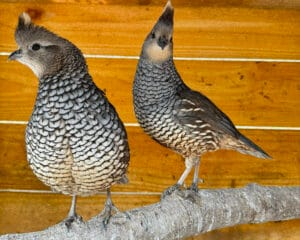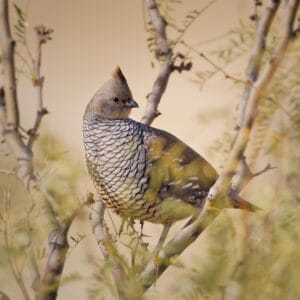Scaled Quail

The Blue Scale Quail (Callipepla squamata): A Desert Dweller of the Southwest
Overview
The Blue Scale Quail, commonly referred to as the Scaled Quail due to its distinctive feather pattern, is a striking bird native to the arid and semi-arid regions of the southwestern United States and northern Mexico. Known for its bluish-gray, scale-like feathering and hardy nature, the Blue Scale Quail is a ground-dwelling bird that thrives in desert grasslands, mesquite scrub, and open prairies. Unlike its cousin, the more widely known Bobwhite Quail, the Scaled Quail is built for endurance in some of the harshest terrains of North America.
Taxonomy and Subspecies
Scientific Name: Callipepla squamata
Family: Odontophoridae (New World Quail)
Order: Galliformes
Common Names: Blue Scale Quail, Scaled Quail, Cottontop Quail
Recognized Subspecies:
C. s. squamata – The nominate subspecies, found in Texas and New Mexico.
C. s. pallida – Found in southeastern Arizona and Sonora.
C. s. castanogastris – Also known as the Chestnut-bellied Scaled Quail.
C. s. hargravei – Smaller and more lightly scaled, native to parts of New Mexico and Colorado.
Physical Description
The Scaled Quail is a medium-sized quail, measuring about 10 to 13 inches (25–33 cm) in length and weighing 6 to 7 ounces (170–200 g). It gets its name from the unique scale-like pattern on its breast and belly, formed by the pale edges of its bluish-gray feathers.
Key Features:
Crest: A short, bushy white or pale crest often likened to a puff of cotton, earning it the nickname “Cottontop.”
Coloration: Overall bluish-gray with a scaled pattern on the neck, breast, and belly. Some subspecies feature a brown or chestnut tint on the lower belly.
Bill: Short and stout, adapted for pecking seeds and insects.
Distribution and Habitat
Geographic Range:
The Blue Scale Quail ranges across:
Southwestern U.S.: Texas, New Mexico, Arizona, Colorado, and Oklahoma.
Northern Mexico: Chihuahua, Coahuila, Sonora, Durango, and other states.
Preferred Habitats:
Arid grasslands
Desert scrublands
Mesquite flats
Open woodlands
Agricultural edges
The species avoids densely forested or overly wet environments, preferring dry, open country with sparse vegetation and ample cover such as cactus, yucca, or sagebrush.
Behavior and Ecology
Social Structure:
Scaled Quail are highly social, often found in coveys (groups) ranging from 8 to 25 birds during the non-breeding season. These coveys help reduce predation risk and improve foraging success.
Diet:
Primarily granivorous, their diet includes:
Seeds (grasses, forbs, mesquite)
Green vegetation (especially in spring)
Insects (important for chicks and during the breeding season)
Movement and Flight:
Scaled Quail are adept runners, often fleeing danger on foot rather than flying. When flushed, they erupt in a low, whirring flight but usually settle back quickly to the ground. Their strong legs and low, crouching posture make them well-adapted to running through brush.
Breeding and Reproduction
Breeding Season:
Typically from April to September, depending on rainfall.
Nesting:
Nests are shallow ground scrapes, often hidden under grass tufts, shrubs, or cactus.
Lined with grass, leaves, and feathers.
A single female may lay 12–14 eggs per clutch.
Incubation period is about 21–23 days.
Chicks are precocial – they hatch fully feathered and capable of walking and feeding themselves.
In good rainfall years, females may raise two broods.
Predators and Threats
Natural predators include:
Raptors (hawks, owls)
Mammals (foxes, coyotes, bobcats)
Snakes
Major human-related threats:
Habitat loss due to agriculture and urban expansion
Overgrazing by livestock
Drought, intensified by climate change, which impacts chick survival and food availability
Conservation Status
The Scaled Quail is currently listed as Least Concern by the IUCN. However, localized population declines have been recorded, particularly in areas with heavy agricultural use or persistent drought.
Conservation Efforts:
Habitat management and restoration
Controlled grazing practices
Supplementary water sources in dry regions
Research into population dynamics and disease
Role in Aviculture and Hunting
Aviculture:
Scaled Quail are sometimes kept in game farms or aviaries due to their unique appearance and adaptability.
Require spacious, dry enclosures with good ground cover.
Hunting:
Considered a challenging and desirable game bird due to its elusive nature and explosive flushing behavior.
Sustainable hunting is supported in several U.S. states with proper licensing and seasonal regulation.
Conclusion
The Blue Scale Quail is a resilient and charismatic representative of North America’s desert birdlife. With its shimmering, scale-like plumage, strong legs, and social habits, it exemplifies the adaptations needed to survive in tough, arid environments. While not currently endangered, ongoing conservation and habitat stewardship are essential to ensure this desert gem continues to thrive across its native range.

